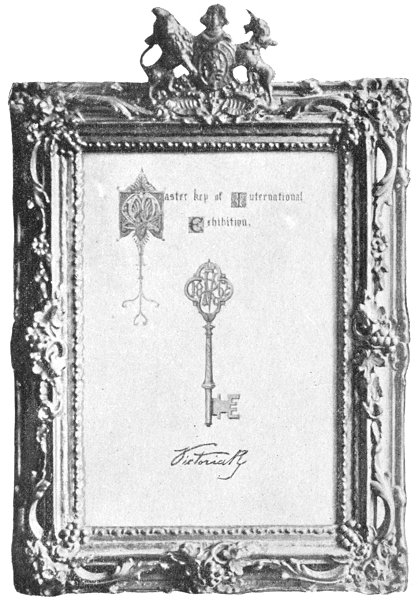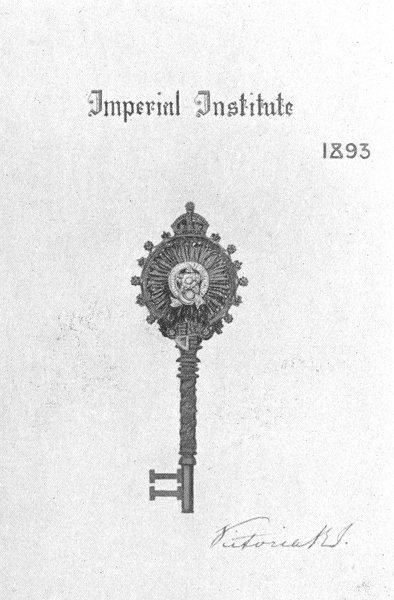|
Ceremonial Keys and Caskets
The production of ornamental metal work
by Chubb's has extended over a long period. Among early
caskets they were concerned with was one of solid silver
made for the King of Ashantee in 1844. It was of elaborate
design, weighed 276 oz. and was constructed for the safe
custody of the gold dust which his sable Majesty employed as
currency. In the Ashantee War of 1873-4 the casket was
captured at Coomassie by the British Forces, and was
returned to Messrs. Chubb for repair, having been purchased
by a British officer at the sale of booty at Cape Coast
Castle.
|
|

Drawing of the key of the 1862 exhibition.
Signed by Queen Victoria. |
Among other interesting indications of
Chubb's participation in the provision of ceremonial caskets
and keys are a series of designs for presentation keys
prepared for opening ceremonies in connection with various
public buildings and exhibitions, and bearing the signs
manual of the exalted personages associated with their
inauguration. Two of the most important are the
representation of the elaborate wrought steel key used by
her late Majesty, Queen Victoria, in opening the
International Exhibition of 1862 in London, and that with
which the late King Edward, as Prince of Wales, inaugurated
the Dublin Exhibition of 1865, the former of which is
illustrated.
Both keys were fine examples of hand
wrought steel, and by reason of the laborious work involved,
as costly as many latterly made in precious metals for
kindred purposes. In these cases, as in other instances
which will be referred to, the finished designs were
graciously autographed by their Majesties, and remain valued
possessions of the Chubb firm. Other designs bearing the
signature of Queen Victoria are those for the Liverpool
Exhibition of 1886, and the Indian and Colonial Exhibition
(London) in the same year; while to those used in connection
with other exhibitions and public institutions are appended
the signatures of the late King Edward VII, Queen Alexandra,
the late Duke of Clarence, the Princess Royal and the late
King Leopold of Belgium. |
| These drawings by Mr. Walter G. Churcher are highly finished in colour on vellum in the
manner of a miniature painting. Perhaps one of the most
notable and valuable keys devised for such a purpose was
that prepared for the opening of the Imperial Institute in
London by Queen Victoria in 1893. |
|
The various dominions of the
British Empire vied in contributing gold and precious stones
of great value for its construction, and the designers were
faced with the unusual difficulty of having so large a
selection of material at their disposal as to render it by
no means easy to include a portion from each of the generous
representative contributions in so small an object as a key.
Even after this requirement had been strictly complied with,
gold and fine stones remained. These, however, were largely
utilised by their incorporation in a specially devised
brooch-like ornament in the form of an orb, approved by Her
Majesty, and affixed by a detachable fastening to the case
of the key.
The following are the details of the
materials of the key: The wards of the key form the letters
I.I., the initials of the Imperial Institute. The gold and
diamonds of which the key is composed were contributed by
several Dominion Governments and by India, so that different
portions of the British Empire are represented by its
various component parts. The head of the key is formed of
gold from South Africa; the silver in the star ornaments
came from the Broken Hill Mine, Australia; the stem is
formed of gold from British Columbia; while the bitt and
wards are composed of the precious metal from Queensland
mines. The stem of the key is encircled by a riband in red
gold and a wreath of laurel leaves in green gold, both
obtained from Victoria, while gold from that colony afforded
material for the ornaments upon the lid of the case
containing the key.
|

The gold jewelled key used by Queen
Victoria at the opening of the Imperial Institute in 1893. |
| The diamonds in the key and case ornament came from South
Africa, the rubies from Burmah, and
the pearls from Ceylon. It would be difficult to imagine
objects which, in so small a compass, could more fully
symbolise the splendid loyalty of the Overseas Dominions to
the Empire, devotion which has since found wider expression
in the magnificent and unexampled rally to the Flag in the
Great War. |
| The ordinary ceremonial casket devised
as a receptacle for honorary freedoms, and for records in
foundation stones, is often open to objection on artistic
grounds; the excess of ornament and the stipulated inclusion
in the design of civic coats of arms, local views, portraits
of evanescent officials and lengthy inscriptions, often
rendering impossible that reticence and simplicity which
begets dignity. In two cases recalled by the writers,
however, opportunities were afforded for associating
appropriate austerity with the form of the caskets placed
respectively in the foundation stone of the Royal Naval
College at Dartmouth in 1902 by his late Majesty King Edward
VII; and that in which King George V, as Prince of Wales,
placed the records deposited at the inauguration of the
Dover Harbour Extension in 1909. In both cases oak and
copper from the old Britannia training ship was utilised for
their construction, and as the included illustration
indicates. They were devised with a view to strength and
simplicity in keeping with the traditions of the Service
with which both events were associated. |

The oak and copper casket, placed by
King George V (then the Prince of Wales) in the foundation
stone of the Dover harbour extension in 1909. |
|
Many other instances could be referred
to, but the foregoing details will serve to indicate that
Chubb's have, during long years, taken a prominent part in
the production of ceremonial craftsmanship. Before taking
leave of this subject it may be of interest to note that in
the "Morning Herald" of March 1st, 1847, the following
announcement appeared:
"On Thursday last Mr. Chubb, of St.
Paul's Churchyard, took the customary oaths at the Lord
Chamberlain's office, on receiving the honour of being
appointed patent lock manufacturer in ordinary to her
Majesty."
This appointment made by her late Majesty Queen Victoria was
continued to members of the family in the reign of King
Edward VII and has been held during the present reign by Sir
George Hayter Chubb and his co-managing directors. |
 |
|
 |
|
 |
Return to
Chapter 3 |
|
Return to
the contents |
|
Proceed to
Chapter 5 |
|